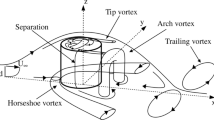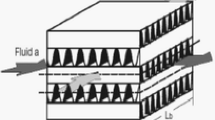Abstract
Heat transfer dissipation from a horizontal rectangular fin embedded with equilateral triangular perforations is computed numerically using one-dimensional finite element technique. The bases of the triangles are parallel and toward the fin base. The body of the fin is discretized into a number of subdivisions (finite elements). The number of these elements can be altered as required according to the automatic mesh generation. The heat dissipation of the perforated fin is computed and compared with that of the solid one of the same dimensions and same thermal properties. The comparison refers to acceptable results and heat dissipation enhancement due to certain perforation.
Similar content being viewed by others
Abbreviations
- A:
-
cross sectional area of the solid fin (m2)
- A c :
-
cross sectional area of the triangle perforation (m2)
- A e :
-
cross sectional area of the finite element (m2)
- A pc :
-
area of the inner surface of the perforation (m2)
- A ps :
-
area of the perforated surface of the fin (m2)
- b :
-
triangle perforation dimension (m)
- h :
-
heat transfer coefficient (W/m2°C)
- h pc :
-
heat transfer coefficient of the inner surface of the perforation (W/m2°C)
- h ps :
-
heat transfer coefficient of the perforated surface of the fin (W/m2 °C)
- h s :
-
heat transfer coefficient of surface of the two sides of the fin (W/m2 °C)
- h t :
-
heat transfer coefficient of the fin tip (W/m2 °C)
- k :
-
thermal conductivity of fin material (W/m °C)
- L :
-
fin length (m)
- l :
-
vector unit (m)
- Le:
-
finite element length (m)
- N :
-
number of perforations
- P :
-
fin perimeter (m)
- Pe:
-
finite element perimeter (m)
- Q :
-
fin heat dissipation rate (W)
- RQF:
-
ratio of heat dissipation rate of perforated fin to that of non-perforated (solid) one
- S :
-
perforation spacing (m)
- t :
-
fin thickness (m)
- Ve:
-
finite element volume (m 3)
- W :
-
fin width (m)
- b:
-
fin base
- e:
-
finite element
- max:
-
maximum
- pf:
-
perforated fin
- pc:
-
inner surface of the perforation (lining surface of the perforation)
- ps:
-
perforated surface which is the remaining solid portion of the perforated fin
- s:
-
solid surfaces of the fin sides
- sf:
-
solid (non-perforated) fin
- t:
-
fin tip
- x :
-
in or along the direction of x-axis
- y :
-
in or along the direction of y-axis
- z :
-
in or along the direction of z-axis
- ∞:
-
ambient
References
Bergles, A.E.: Technique to augment heat transfer. In Handbook of heat transfer Applications. In: Rohsenow W.M., Hartnett J.P., Ganic E.N. (eds.), Chap. 3, 2nd edn. McGraw-Hill Book company, New York (1985)
Shah R.K.: Classification of heat exchangers. In: Kakac, S., Bergles, A., Mayinger, F. (eds) Heat Exchangers, Thermal-Hydraulic Fundamentals and Design, Hemisphere Publishing, New York (1981)
Mullisen R., Loehrke R.: A study of flow mechanisms responsible for heat transfer enhancement in interrupted-plate heat exchangers. J. Heat Transfer (Trans. ASME) 108, 377–385 (1986)
Prasad, B.V.S.S.S., Gupta, A.V.S.S.K.S.: Note on the performance of an optimal straight rectangular fin with a semicircular cut at the tip. Heat transfer Eng. vol. 14, no. 1 (1998)
Al-Essa, A.H.: Enhancement of thermal performance of fins subjected to natural convection through body perforation. PhD Thesis, Department of Mechanical Engineering, University of Baghdad, Iraq and Jordan University of Science and Technology (2000)
Sparrow E.M., Carranco Oritz M.: Heat transfer coefficient for the upstream face of a perforated plate positioned normal to an oncoming flow. Int. J. Heat Mass Transfer 25(1), 127–135 (1982)
Al-Essa A.H., Al-Hussien F.M.S.: The effect of orientation of square perforations on the heat transfer enhancement from a fin subjected to natural convection. Heat Mass Transfer 40, 509–515 (2004)
Kutscher C.F.: Heat exchange effectiveness and pressure drop for air flow through perforated plates with and without crosswind. J. Heat transfer 116, 391–399 (1994)
Razelos P., Georgiou E.: Two-Dimensional effects and design criteria for convective extended surfaces. Heat Transfer Eng. 13(3), 38–48 (1992)
Aziz A., Lunadini V.: Multidimensional steady conduction in convicting, radiating, and convicting-radiating fins and fin assemblies. Heat Transfer Eng. 16(1), 32–64 (1995)
Rao S.S.: The Finite Element Method in Engineering, 2nd edn. Pergamon, Elmsford (1989)
Incropera F.P., Dewitt D.P.: Fundamentals of Heat and Mass Transfer, 4th edn. Wiley, New York (1996)
Author information
Authors and Affiliations
Corresponding author
Rights and permissions
About this article
Cite this article
AlEssa, A.H.M. One-dimensional finite element heat transfer solution of a fin with triangular perforations of bases parallel and towered its base. Arch Appl Mech 79, 741–751 (2009). https://doi.org/10.1007/s00419-008-0250-5
Received:
Accepted:
Published:
Issue Date:
DOI: https://doi.org/10.1007/s00419-008-0250-5




